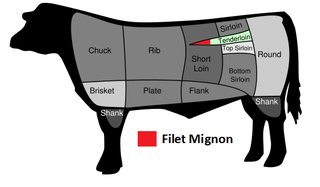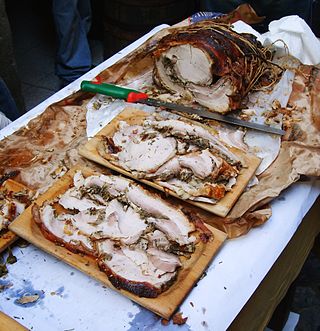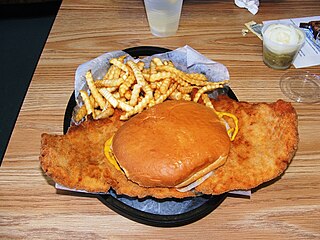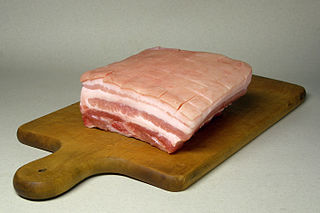
A beefsteak, often called just steak, is a flat cut of beef with parallel faces, usually cut perpendicular to the muscle fibers. In common restaurant service a single serving has a raw mass ranging from 120 to 600 grams. Beef steaks are usually grilled, pan-fried, or broiled. The more tender cuts from the loin and rib are cooked quickly, using dry heat, and served whole. Less tender cuts from the chuck or round are cooked with moist heat or are mechanically tenderized.
Venison originally meant the meat of a game animal but now refers primarily to the meat of deer. Venison can be used to refer to any part of the animal, so long as it is edible, including the internal organs. Venison, much like beef or pork, is categorized into specific cuts, including roast, sirloin, and ribs.

A butcher is a person who may slaughter animals, dress their flesh, sell their meat, or participate within any combination of these three tasks. They may prepare standard cuts of meat and poultry for sale in retail or wholesale food establishments. A butcher may be employed by supermarkets, grocery stores, butcher shops and fish markets, slaughter houses, or may be self-employed.

A beef tenderloin, known as an eye fillet in Australasia, filet in France, filé mignon in Brazil, and fillet in the United Kingdom and South Africa, is cut from the loin of beef.

Filet mignon is a cut of meat taken from the smaller end of the tenderloin, or psoas major of a cow. In French, it mostly refers to cuts of pork tenderloin.

Porchetta or Porquette in France, is a savory, fatty, and moist boneless pork roast from Italy and the French region of Nice. The carcass is deboned and spitted or roasted traditionally over wood for at least eight hours, fat and skin still on. In some traditions, porchetta is stuffed with liver and wild fennel, though many versions do not involve stuffing. Porchetta is usually heavily salted and can be stuffed with garlic, rosemary, fennel, or other herbs, often wild. Porchetta has been selected by the Italian Ministry of Agricultural, Food and Forestry Policy as a prodotto agroalimentare tradizionale, one of a list of traditional Italian foods held to have cultural relevance.

Chuck steak is a cut of beef and is part of the sub-prime cut known as the chuck.
A pork steak, also called Boston butt or pork blade steak, is a steak cut from the shoulder of the pig.

Pulled pork is an American barbecue dish, more specifically a dish of the Southern U.S., based on shredded barbecued pork shoulder. It is typically slow-smoked over wood ; indoor variations use a slow cooker. The meat is then shredded manually and mixed with a sauce. It may be served on bread as a sandwich, or eaten on its own.

During butchering, beef is first divided into primal cuts, pieces of meat initially separated from the carcass. These are basic sections from which steaks and other subdivisions are cut. Since the animal's legs and neck muscles do the most work, they are the toughest; the meat becomes more tender as distance from hoof and horn increases.

Pork tenderloin, also called pork fillet, pork steak or Gentleman's Cut, is a long, thin cut of pork.

A primal cut or cut of meat is a piece of meat initially separated from the carcass of an animal during butchering. Examples of primals include the round, loin, rib, and chuck for beef or the ham, loin, Boston butt, and picnic for pork.

The pork tenderloin sandwich, also known as a breaded pork tenderloin sandwich (BPT), contains a breaded and fried cutlet similar to Wiener Schnitzel and is popular in the Midwest region of the United States, especially in the states of Indiana, Illinois, Missouri and Iowa. The sandwich is claimed to have originated at Nick's Kitchen restaurant in Huntington, Indiana, near Fort Wayne.

The beef clod or shoulder clod is one of the least expensive cuts of beef and is taken from the shoulder (chuck) region of the animal. Beef clod is a large muscle system, with some fat that covers the muscles. The clod's composition is mainly three muscles: the shoulder tender, the top blade and the clod heart and is one of two chuck subprimal cuts. It is often divided into its three separate muscle cuts for retail sale.

Pork is the culinary name for the meat of the pig. It is the most commonly consumed meat worldwide, with evidence of pig husbandry dating back to 5000 BCE.

A rib chop, or rib end cut, is a cut of meat that comes from the rib section of an animal. The term is usually used for pork and lamb. Rib chops are considered the ribeye of pork and lamb.

The cuts of pork are the different parts of the pig which are consumed as food by humans. The terminology and extent of each cut varies from country to country. There are between four and six primal cuts, which are the large parts in which the pig is first cut: the shoulder, loin, belly and leg. These are often sold wholesale, as are other parts of the pig with less meat, such as the head, feet and tail. Retail cuts are the specific cuts which are used to obtain different kinds of meat, such as tenderloin and ham. There are at least 25 Iberian pork cuts, including jamón.

A steak is a thick cut of meat generally sliced across the muscle fibers, sometimes including a bone. It is normally grilled or fried. Steak can be diced, cooked in sauce, such as in steak and kidney pie, or minced and formed into patties, such as hamburgers.

Baseball steak is a center cut of beef taken from the top sirloin cap steak. Baseball steaks differ from sirloin steaks in that the bone and the tenderloin and bottom round muscles have been removed; and the cut is taken from biceps femoris. A baseball steak is essentially a center cut top sirloin cap steak. This cut of beef is very lean, and is considered very flavorful.




















